

Playing with Scala Parser Combinator. Notice The work in this article is in progress.
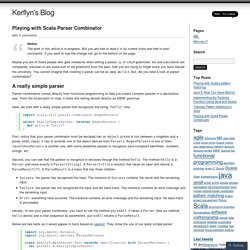
But you are free to read it in its current state and free to post comments. If you want to see the change set, go to the bottom of the page. Maybe you are of those people who gets headache when writing a parser. LL or LALR grammars, lex and yacc/bison are completely unknown or are some sort of old phantoms from the past, that you are trying to forget since you have leaved the university. Lihaoyi.github. Val number: P[Int] = P( CharIn('0'to'9').rep(1).!.
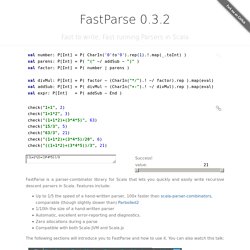
Map(_.toInt) ) val parens: P[Int] = P( "(" ~/ addSub ~ ")" ) val factor: P[Int] = P( number | parens ) val divMul: P[Int] = P( factor ~ (CharIn("*/").! ~/ factor).rep ).map(eval) val addSub: P[Int] = P( divMul ~ (CharIn("+-").! ~/ divMul).rep ).map(eval) val expr: P[Int] = P( addSub ~ End ) check("1+1", 2) check("1+1*2", 3) check("(1+1*2)+(3*4*5)", 63) check("15/3", 5) check("63/3", 21) check("(1+1*2)+(3*4*5)/20", 6) check("((1+1*2)+(3*4*5))/3", 21) FastParse is a parser-combinator library for Scala that lets you quickly and easily write recursive descent parsers in Scala. Up to 1/5 the speed of a hand-written parser, 100x faster than scala-parser-combinators, comparable (though slightly slower than) Parboiled2 1/10th the size of a hand-written parser Automatic, excellent error-reporting and diagnostics.
The following sections will introduce you to FastParse and how to use it. To begin using FastParse, add To your SBT configuration. External DSLs made easy with Scala Parser Combinators. External DSLs are hard since implementing them involves reinventing most of the mechanisms found in a general purpose language.

Designing internal DSLs are equally hard, more so in a statically typed language. Dynamically typed languages like Ruby offer strong meta-programming facilities, which help in implementing internal DSLs. But metaprogramming in Ruby is still considered elitist by many, and is not an art mastered by programmers at large. Parser combinators offer a unique value here. They allow programmers to write executable grammars, in the sense that designing and implementing a DSL is almost equivalent to writing the EBNF notations in the syntax of the native language. The basic idea is to view the operators of BNF (or regular expressions for that matter) as methods that operate on objects representing productions of a grammar. Combinators have their theoretical underpinnings in functional programming.
And here is the Scala parser for recognizing the DSL .. An Introduction To Scala Parser Combinators - Part 1: Parser Basics. Sven efftinge's blog: Parsing Expressions with Xtext. Parsing simple XML-like, structural languages with Xtext is a no-brainer.
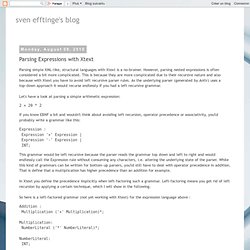
However, parsing nested expressions is often considered a bit more complicated. This is because they are more complicated due to their recursive nature and also because with Xtext you have to avoid left recursive parser rules. VisuaLangLab — Java.net. Meinte's DSL Blog. Regular language. In theoretical computer science and formal language theory, a regular language is a formal language that can be expressed using a regular expression.
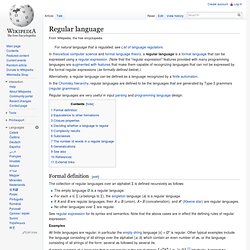
(Note that the "regular expression" features provided with many programming languages are augmented with features that make them capable of recognizing languages that can not be expressed by the formal regular expressions (as formally defined below).) Alternatively, a regular language can be defined as a language recognized by a finite automaton. In the Chomsky hierarchy, regular languages are defined to be the languages that are generated by Type-3 grammars (regular grammars). Regular languages are very useful in input parsing and programming language design. Formal definition[edit] The collection of regular languages over an alphabet Σ is defined recursively as follows: See regular expression for its syntax and semantics.
Examples All finite languages are regular; in particular the empty string language {ε} = Ø* is regular. Then the set . Let in. LL parser. In computer science, an LL parser is a top-down parser for a subset of the context-free grammars.
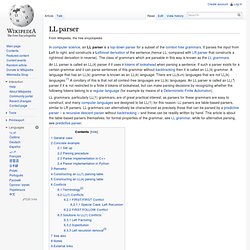
It parses the input from Left to right, and constructs a Leftmost derivation of the sentence (hence LL, compared with LR parser that constructs a rightmost derivation in reverse). The class of grammars which are parsable in this way is known as the LL grammars. LL grammars, particularly LL(1) grammars, are of great practical interest, as parsers for these grammars are easy to construct, and many computer languages are designed to be LL(1) for this reason. LL parsers are table-based parsers, similar to LR parsers. LL grammars can alternatively be characterized as precisely those that can be parsed by a predictive parser – a recursive descent parser without backtracking – and these can be readily written by hand.
General case[edit] The parser works on strings from a particular context-free grammar. Xtext. Build the Language You Want!

Xtext can build full-featured text editors for both general-purpose and domain-specific languages. In the background it uses the LL(*) parser generator of ANTLR, allowing to cover a wide range of syntaxes. Xtext editors have already been implemented for JavaScript, VHDL, Xtend, and many other languages. Compile to Whatever You Want! You define the target format to which your language is compiled. Highly Customizable The default behavior of Xtext is optimized to cover a wide range of languages and use cases. Single Sourcing The grammar definition language of Xtext is not just for the parser. Incremental Compiler Xtext is built to scale, so no matter if you have a few source files written in your language or hundreds of them, the IDE remains responsive and reacts smoothly to any text change. Compatible with Graphical Editors You can combine the text-based formats created with Xtext with many graphical editing frameworks, e.g. Xtend. Eclipse poprawia Javę. Witaj Xtend! Xtend został udostępniony w postaci pluginów do zintegrowanego środowiska programistycznego Eclipse (IDE) wyposażonego w Java Development Tools (JDT).
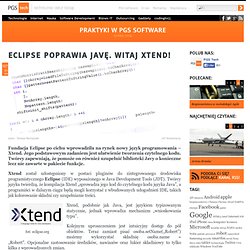
Twórcy języka twierdzą, że kompilacja Xtend „sprowadza jego kod do czytelnego kodu języka Java”, a programiści w dalszym ciągu będą mogli korzystać z wbudowanych udogodnień IDE, takich jak kolorowanie składni czy uzupełnianie treści. fot: eclipse.org Xtend, podobnie jak Java, jest językiem typizowanym statycznie, jednak wprowadza mechanizm „wnioskowania typu”. Kolejnym uproszczeniem jest intuicyjny dostęp do pól obiektów. Teraz zamiast pisać osoba.setName(„Robert”) możemy wykorzystać składnię osoba.name = „Robert”. Eclipse opisuje bibliotekę Xtend jako „cienką warstwę nakładaną na JDK”, dzięki czemu kod pisany w języku Xtend może być wywoływany bezpośrednio z programu opartego o Java. Xtend Intro from Xtext Team on Vimeo. Naszym zdaniem Xtend jest doskonałym pomysłem. Podobne artykuły: Źródło: theregister.co.uk, eclipse.org.
ANTLR Parser Generator.